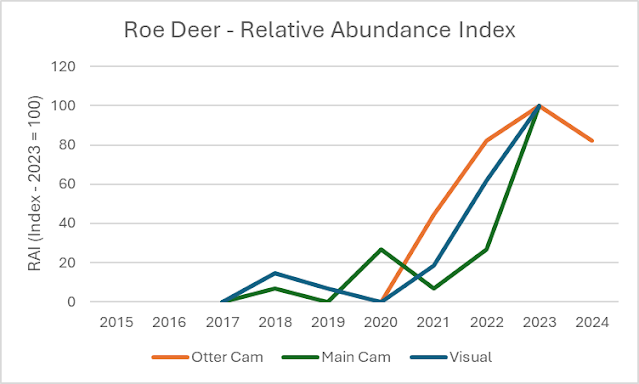My patch has been consistently monitored since 2008 and has been under Trail Camera observation since 2014 it is with some confidence then that there were little to no Roe Deer using the site up until their first appearance in 2017.
The Saxon Mill region is good Roe Deer habitat with a mixture of farmland, rough grassland and ephemeral shrub and wet woodland. Quiet stretches of habitat run along the riverbank from Rock Mill northwards and intersects with a railway line that offers excellent connectivity throughout the area. The railway in particular is of great value to dispersing deer and was the primary route for a Roe Deer doe being spotted in Warwick Town Centre in Priory Park in 2023.
Roe Deer Abundance
This increase in abundance from 2020 reflects an increase in productivity.
Roe Deer Productivity
Relative abundance increased as a direct result of consistent breeding from 2021 which included a set of twins born in both 2022 and 2023.
|
Year |
Number of kids born |
Date Kid first seen (Week Number) |
Relative Abundance Index |
||
|
Main Cam |
Otter Cam |
Visual |
|||
|
2018 |
0 |
- |
0.0001 |
- |
0.11 |
|
2019 |
1 |
1st April (Week 14) |
0.0000 |
- |
0.05 |
|
2020 |
0 |
- |
0.0004 |
- |
0.00 |
|
2021 |
1 |
24th May (Week 21) |
0.0001 |
0.93 |
0.14 |
|
2022 |
2 |
17th July (Week 28) |
0.0004 |
1.71 |
0.47 |
|
2023 |
2 |
3rd July (Week 27) |
0.0015 |
2.07 |
0.76 |
|
2024 |
1 |
10th June (Week 26) |
- |
1.71* |
- |






No comments:
Post a Comment